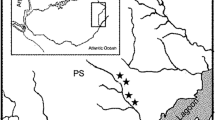Abstract
Mate choice is not just a female preoccupation. Under some circumstances, males may also be choosy. However, studies of male mate choice have generally been confined to situations where males can make direct comparisons between potential partners. In contrast, sequential male mate choice has largely been overlooked despite its biologically importance, especially if current investment in mate attraction diminishes a male’s future mating opportunities. Using the Pacific blue-eye fish Pseudomugil signifer, we show that males are capable of exercising sequential mate choice. When presented sequentially with large and small females, males spent more effort courting the former. However, males did not appear to modify the time spent courting a given female based on the size of the female encountered previously. We suggest that greater attention to the sequential choice problem in males may help illuminate similarities and differences between the sexes when it comes to mating decisions.

Similar content being viewed by others
References
Bakker TCM, Milinski M (1991) Sequential female choice and the previous male effect in sticklebacks. Behav Ecol Sociobiol 29:205–210
Bakker TCM, Rowland WJ (1995) Male mating preference in sticklebacks: effects of repeated testing and own attractiveness. Behaviour 132:936–949
Bateman AJ (1948) Intra-sexual selection in Drosophila. Heredity 2:349–368
Bateman PW, Gilson LN, Ferguson JWH (2001) Male size and sequential mate preference in the cricket Gryllus bimaculatus. Anim Behav 61:631–637
Bonduriansky R (2001) The evolution of male mate choice in insects: a synthesis of ideas and evidence. Biol Rev 76:305–339
Engqvist L, Sauer KP (2001) Strategic male mating effort and cryptic male choice in a scorpionfly. Proc R Soc Lond B 268:729–735
Forbes MR, Boates JS, McNeil NL, Brison AE (1996) Mate searching by males of the intertidal amphipod Corophium volutator (Pallas). Can J Zool 74:1479–1484
Griffith SC, Sheldon BC (2001) Phenotypic plasticity in the expression of sexually selected traits: neglected components of variation. Anim Behav 61:987–993
Jenkins JR, Rowland WJ (1997) Learning influences courtship preferences of male threespine sticklebacks (Gasterosteus aculeatus) Ethology 103:954–965
Jennions MD, Petrie M (1997) Variation in mate choice and mating preferences: a review of causes and consequences. Biol Rev 72:283–327
Judge KA, Brooks RJ (2001) Chorus participation by male bullfrogs, Rana catesbeiana: a test of the energetic constraints hypothesis. Anim Behav 62:849–861
Kotiaho JS (2001) Costs of sexual traits: a mismatch between theoretical considerations and empirical evidence. Biol Rev 76:365–376
Milinski M (2001) The economics of sequential mate choice in sticklebacks. In: Dugatkin LA (ed) Model systems in behavioral ecology: integrating conceptual, theoretical and empirical approaches. Princeton University Press, Princeton, N.J., pp 245–264
Milinski M, Bakker TCM (1992) Costs influence sequential mate choice in sticklebacks, Gasterosteus aculeatus. Proc R Soc Lond B 250:229–233
Pitcher TE, Neff BD, Rodd FH, Rowe L (2003) Multiple mating and sequential mate choice in guppies: females trade up. Proc R Soc Lond B 270:1623–1629
Real L (1990) Search theory and mate choice. I. Models of single-sex discrimination. Am Nat 136:376–404
Rowland WJ (1982) Mate choice by male sticklebacks, Gasterosteus aculeatus. Anim Behav 30:1093–1098
Rowland WJ (1989) The ethological basis of mate choice in male threespine sticklebacks, Gasterosteus aculeatus. Anim Behav 38:112–120
Saethers SA, Fiske P, Kålås JA (2001) Male mate choice, sexual conflict and strategic allocation of copulations in a lekking bird. Proc R Soc Lond B 268:2097–2102
Verrell PA (1995) Males choose larger females as mates in the salamander Desmognathus santeelah. Ethology 99:162–171
Wong BBM (2004) Superior fighters make mediocre fathers in the Pacific blue-eye fish. Anim Behav 67:583–590
Wong BBM, Jennions MD (2003) Costs influence male mate choice in a freshwater fish. Proc R Soc Lond B [Suppl] 270:s36–s38 (DOI 10.1098/rsbl.2003.0003)
Wong BBM, Keogh JS, Jennions MD (2004) Mate recognition in a freshwater fish: geographic distance, genetic differentiation, and variation in female preference for local over foreign males. J Evol Biol (in press)
Acknowledgements
We thank P. Backwell, A. Cockburn, R. Magrath, S. Blomberg, J. Stapley and three anonymous reviewers for their insightful comments, and all those who helped in the field. Financial assistance was provided by the Seaworld Research and Rescue Foundation, Joyce Vickery Scientific Research Fund, Ethyl Mary Read Fund and the Australian Geographic Society (to B.B.M.W.), and the Australian Research Council (to M.D.J. and J.S.K.). Our study complies with all the relevant State, Territory and Commonwealth laws of Australia.
Author information
Authors and Affiliations
Corresponding author
Additional information
Communicated by T. Czeschlik
Rights and permissions
About this article
Cite this article
Wong, B.B.M., Jennions, M.D. & Keogh, J.S. Sequential male mate choice in a fish, the Pacific blue-eye Pseudomugil signifer . Behav Ecol Sociobiol 56, 253–256 (2004). https://doi.org/10.1007/s00265-004-0775-8
Received:
Revised:
Accepted:
Published:
Issue Date:
DOI: https://doi.org/10.1007/s00265-004-0775-8




